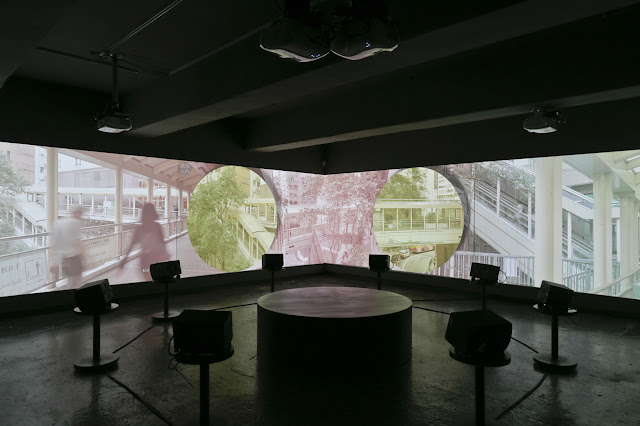Routes Guided via Constructed Interfaces
Daum Kim's work is the constructed domain based on interfaces. An interface refers to a physical and virtual medium designed to enable interaction and communication between objects or between objects and humans at the boundaries between dissimilar sorts. In other words, the concept of the connection environment seems appropriate to explain his work. This is because the artist's work captures the pattern of life or the state of society created on top of diverse social networks in the form of art by constructing an interface that crosses boundaries or intersects separated relationships. He observes a variety of structures and systems from the physical space that he encounters around him to the online environment and their operation principles and adds another narrative to them. It crosses the private and public domains and evokes social, cultural, political, and historical contexts at the macroscopic level based on memories or experiences at the microscopic level. Daum Kim's interface, which is extremely private and expands into a universal context at the same time, establishes some sort of events or a situations in the gap of space and becomes visible as a place.
The sense of penetrating the interface presented by the artist is generally linear and is not an easily readable narrative. He sometimes deviates from explicit narrative threads through ambiguous intent or fragmented text and draws the audience to an inconclusive destination. He also induces a certain tension through a series of sliding images that abscond from the smooth progression of the video. In addition, the sound, which generates a unique sense of presence, is in discord with the situation or image that the audience encounters. Moreover, it even aggressively demands emotional intervention from its spectators. Utilizing reproduced and constructed spaces at the macroscopic level in this manner, the flip side of formally imaged phenomena, and our interest in the realm of life that we live in, Daum Kim's work encourages us to adapt and experience through abstract senses of daily life that are often scattered rather than through clear narratives.
The artist summons the exhibition (venue) as the interface in his early work Mutually Mediated (2013). Precisely, some sort of virtual space reconstructed using computer graphics covered in dry and cold skin without any human body heat coincides with the narrative commencing the exhibition and presumes the environment as an exhibition hall. First of all, the viewpoint in the video penetrates and enters the digital display and swims in the space at a slow speed. Also, narratives that recite the hierarchy of communication and creative possibilities inherent in the form of viewing are added. Then, a character encountered on social media is incorporated as a part of the narrative to discuss the possibility/impossibility of communication. The clamorous conversation noise of people that can be heard intermittently and the lethargic background sounds push you to be immersed deeper in the imaginary situation guided by the narrative in the expressionless digital space. Ultimately, narratives that end in the inability to fully understand each other's intentions are embroidered on the transparent background of infinite and vastly open graphic tools, creating interesting paradoxes in themselves. An exhibition hall filled with floating words and writing, in other words, the artist acknowledges the intentions that cannot be fully matched under the horizon of the senses and the exteriors of words and writings presented by the exhibition experience. At the same time, because adequate communication is impossible, he leads to a narrative of division and expansion in the sense of making it possible.
On the other hand, the construction of the artist's interface encompasses the macroscopic context and is also visualized in a way that generates emotion. For example, in Three Suns (2018), which is based on a specific place, Daum Kim deals with today's conflict over the historical meaning of Gwangju against the backdrop of the architectural structure and purpose of the Asia Plaza, the wide open space in front of the Asia Culture Center (ACC) in Gwangju. Unlike the public building style that can generally be seen, the structure of the ACC is dug down from the ground level and the Asia Plaza located in the middle has the character of an open public area like a yard. The artist focuses on the nature of the space, thus its openness. He understands it as a structure that cannot easily accumulate common memories or experiences because of the constantly intersecting movements of people entering the area and also due to the views colliding from various heights. Furthermore, he introduces the Asia Plaza as a place without location-specific properties and provides an experience that overwhelms space through his luminous sound video work splitting from two colors, red and blue to white and black. The endlessly bifurcating video limited to the two-color axes recalls a dichotomous way of thinking and logic and he makes you sense the history of past conflicts, today's repeated divisions, and the signs of events that have been forgotten once again or have not yet occurred beforehand.
KIM Sung woo (curator)
KIM Sung woo is a curator and writer. He is interested in curatorial methodologies to produce/ pose questions based on time and space, and is considering how to achieve subjectivities of individuals in the form of exhibition. KIM directed the curatorial project/ exhibition and management of Amado Art Space, not-for-profit alternative space in Seoul (2015-2019). He was also appointed as a curatorial advisor for the Busan Biennale 2020, SongEun Art Space (2019), and was a curator for the 12th Gwangju Biennale (2018). He currently established a non-profit curatorial space ‘Primary Practice’, and at a same time, active as a member of curatorial collective ‘WESS’.




